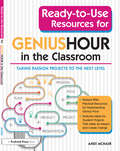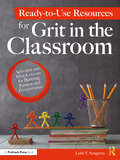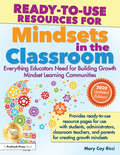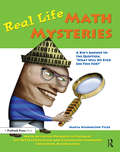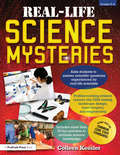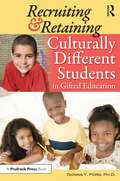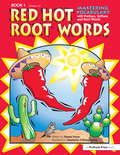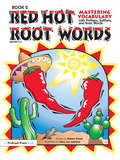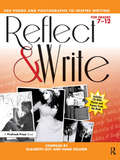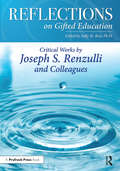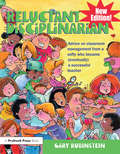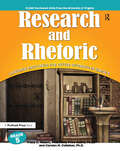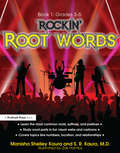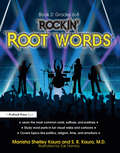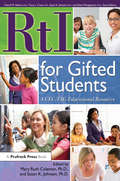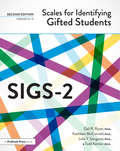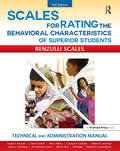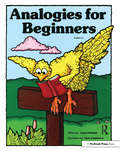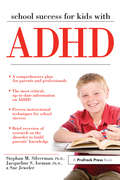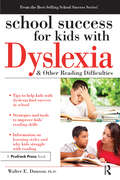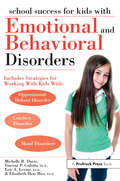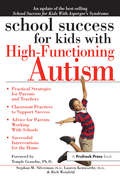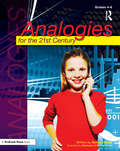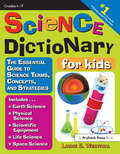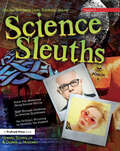- Table View
- List View
Ready-to-Use Resources for Genius Hour in the Classroom: Taking Passion Projects to the Next Level
by Andi McNairReady-to-Use Resources for Genius Hour in the Classroom provides practical advice and a wealth of hands-on resources for teachers to implement Genius Hour, or passion projects, in the classroom. This book: Includes everything educators need to help students apply their learning and reach deep understanding. Engages the six P's of Genius Hour: passion, plan, pitch, project, product, and presentation. Features built-in opportunities to to gamify the process. Helps increase students' critical thinking, creativity, and engagement. Is a valuable standalone resource and companion to Genius Hour. Students can "level up," earning badges and points, as they create, design, and carry out projects and develop ideas that impact their classroom, school, community, and world. Through the tools and tips provided, teachers will see Genius Hour as more than an hour, more than a strategy or activity separate from the regular curriculum. When implemented effectively, Genius Hour can be a more meaningful teaching and learning experience than any other.
Ready-to-Use Resources for Grit in the Classroom: Activities and Mini-Lessons for Building Passion and Perseverance
by Laila Y. SangurasReady-to-Use Resources for Grit in the Classroom provides tools to help teachers, students, and families understand and foster passionate, creative, and curious grit in all students. It can be difficult and time consuming to figure out how to develop grit in the classroom. This resource includes student activities and mini-lessons that can be completed in fewer than ten minutes, with activities on topics from goal setting, to re-examining failure, to optimism. Interactive and engaging, this book challenges students to rethink failure, push past obstacles, and passionately pursue their interests. Featuring helpful teacher instructions and reproducible handouts for each activity, Ready-to-Use Resources for Grit in the Classroom is the perfect addition to any educator's social-emotional learning library.
Ready-to-Use Resources for Mindsets in the Classroom: Everything Educators Need for Building Growth Mindset Learning Communities
by Mary Cay RicciReady-to-Use Resources for Mindsets in the Classroom provides educators with tools they need to help students change their thinking about their abilities and potential. The book features ready-to-use, interactive tools for students, teachers, parents, administrators, and professional development educators. When students believe that dedication and hard work can change their performance in school, they grow to become resilient, successful students.
Real Life Math Mysteries: A Kid's Answer to the Question, "What Will We Ever Use This For?" (Grades 4-10)
by Marya Washington TylerZookeeper, horse stable owner, archaeologist, lawyer, pilot, fireman, newspaper editor, dairy farmer, arson detective . . . these are just a few of the real people who, in their own words, share their own daily encounters with mathematics. How much lettuce does the Pizza Hut manager need to order for next week? How many rose bushes can a gardener fit around a wading pool? How many fire hoses will be needed to extinguish the fire? Your students will be amazed at the real-life math faced by truck drivers, disc jockeys, farmers, and car mechanics.Real Life Math Mysteries introduces students to math in the real world through a series of problems drawn from a vast array of community leaders, business professionals, and city officials. The problems are designed to stimulate students' creative thinking and teach the value of math in a real-world setting.Each concise and clear problem is provided on a blackline master and includes problem-solving suggestions for students with a comprehensive answer key. The problems are tied to the guidelines for math instruction from the National Council of Teachers of Mathematics. This book will get students thinking about the mathematics all around them.Make math last a lifetime. Students will delight in the real-life approach to math as they realize that they will use math skills over and over again in whatever vocation they choose. Make math an exciting experience that children realize will last a lifetime.More books that make math fun for students include Extreme Math, It's Alive!, and It's Alive! And Kicking!.Grades 4-10
Real-Life Science Mysteries: Grades 5-8
by Colleen KesslerReal-Life Science Mysteries puts an exciting new spin on scientific thinking by profiling real-life scientists, showing students in grades 5-8 ways they can use science in their everyday lives. From a biologist studying the habits of garter snakes in Manitoba, Canada, to a landscape designer and greenhouse owner in Ohio, the scientists in this book share information and solutions to the thorniest problems they face in their scientific careers.With the more than 30 activities included in Real-Life Science Mysteries, students will be required to try their hand at solving common science problems and performing experiments while learning about real people from diverse backgrounds, all of whom share a love for discovering how they work, why things work, and how they can work better. This book is perfect for any science classroom or young scientists looking to increase their knowledge!Grades 5-8
Recruiting and Retaining Culturally Different Students in Gifted Education
by Donna Y. FordOne pervasive educational issue is the national underrepresentation of Black and Hispanic students in gifted education. Virtually every school district is grappling with having too few students from these groups identified as gifted and served in gifted classes and programs. Recruiting and Retaining Culturally Different Students in Gifted Education addresses this long-standing national problem through the dual lens of recruitment and retention. The focus is on how to equitably recruit (screen, refer, and/or assess) culturally different students and, just as importantly, to retain them. Recruitment and retention require providing academic, cultural, and social supports to culturally different students and ensuring that educators are willing and able to address issues and barriers. No time is better than now to address and correct the underachievement albatross, and the focus on recruitment and retention holds the greatest promise.Nominated for a 2014 NAACP Image Award in the Outstanding Literary Work-Instructional Category
Red Hot Root Words: Mastering Vocabulary With Prefixes, Suffixes, and Root Words (Book 1, Grades 3-5)
by Dianne DrazeHelp students improve their mastery of the English language and acquire the keys for understanding thousands of words by studying Greek and Latin word parts (prefixes, root words, and suffixes). This is one of the most complete, usable presentations of vocabulary development using word parts you will find. A knowledge of word parts gives students a head start on decoding words in reading and testing situations. This is the first book in the two-book series. Each of the well-developed lessons in this text includes: one to three word parts along with meanings and sample words, five vocabulary words that use the prefixes or root words, definitions and sample sentences for each of the five words, a practice exercise that lets students apply knowledge of the words and their meanings, and a one-page review worksheet for one or two lessons that presents more unique opportunities to work with the prefixes and root words and to see how they are combined with suffixes. In addition to the student pages, the teacher's information section includes: an extensive listing of the most common prefixes, root words, and suffixes; their meanings and sample words; additional words for each lesson; andlesson ideas to supplement the word being studied.For older students, use Red Hot Root Words, Book 2. Grades 3-5
Red Hot Root Words: Mastering Vocabulary With Prefixes, Suffixes, and Root Words (Book 2, Grades 6-9)
by Dianne DrazeHelp students improve their mastery of the English language and acquire the keys for understanding thousands of words by studying Greek and Latin prefixes, root words, and suffixes. This is one of the most complete, usable presentations of vocabulary development using word parts you will find. A knowledge of word parts gives students a head start on decoding words in reading and testing situations. This book, the second in a two-book series, contains three sections (prefixes, root words, and suffixes), but each section has the same format. Each of the lessons include: two to four prefixes, suffixes, or root words along with meanings and sample words; 10 new vocabulary words that use these word parts; definitions and sample sentences for each new word; and a one-page worksheet that presents a variety of ways to apply knowledge and expand understanding of the definitions and uses of the word parts. In addition to the extensive student section, this book includes considerable reference material to help the instructor. This includes: a comprehensive listing of prefixes, root words, and suffixes; their meanings and sample words; extra words to use with each lesson; open-ended worksheets that can be used with any lesson; and additional lesson ideas to supplement your word study. For younger students, use Red Hot Root Words, Book 1. Grades 6-9
Reflect and Write: 300 Poems and Photographs to Inspire Writing (Grades 7-12)
by Hank Kellner Eliabeth GuyNow more than ever, we must take advantage of students' increasing fascination with graphic images as opposed to written words. Reflect and Write capitalizes on this situation by marrying dynamic images to original poems written by students at the junior and senior high school levels, teachers, and other writers nationwide. Additionally, each page contains keywords, as well as popular quotations by well-known authors, designed to inspire critical thinking. Taken together, the more than 300 poems, photographs, and quotations will help stimulate spirited class discussion and provide prompts that will evoke meaningful writing by students. Like Kellner's previous best-selling book, Write What You See, Reflect and Write will encourage students to read, relate to, and respond to modern verse and inspiring photographs both verbally and in writing. The book includes online access to the photographs and student pages. Grades 7-12
Reflections on Gifted Education: Critical Works by Joseph S. Renzulli and Colleagues
by Joseph Renzulli Sally M. ReisIn this compelling book, more than 40 years of research and development are highlighted in a collection of articles published by Joseph S. Renzulli and his colleagues. Renzulli's work has had an impact on gifted education and enrichment pedagogy across the globe, based on the general theme of the need to apply more flexible approaches to identifying and developing giftedness and talents in young people. This collection of articles and chapters has strong foundational research support focusing on practical applications that teachers can use to create and differentiate learning and enrichment experiences for high potential and gifted and talented students.
Reluctant Disciplinarian: Advice on Classroom Management From a Softy Who Became (Eventually) a Successful Teacher
by Gary RubinsteinIn this funny and insightful book, Gary Rubinstein relives his own truly disastrous first year of teaching. He begins his teaching career armed only with idealism and romantic visions of teaching—and absolutely no classroom management skills. By his fourth year, he is named “Teacher of the Year.” As Rubinstein details his transformation from incompetent to successful teacher, he shows what works and what doesn't work when managing a classroom such as:Develop a teacher look. The teacher look says, “There's nothing you can do that I haven't already seen, so don't even bother trying.”Show students that you are a “real” teacher by doing things they expect of real teachers, at least for a while.Be prepared to utter a decisive answer to anything within 2 seconds. Decisive answers inspire confidence.Any teacher—experienced or not—will enjoy this honest and humorous look at the real world of teaching!
Research and Rhetoric: Language Arts Units for Gifted Students in Grade 5
by Amy Price Azano Carolyn CallahanThe CLEAR curriculum, developed by the University of Virginia's National Research Center on the Gifted and Talented, is an evidence-based teaching model that emphasizes Challenge Leading to Engagement, Achievement, and Results. In Research and Rhetoric: Language Arts Units for Gifted Students in Grade 5, students will engage in a systematic study of rhetoric as contemplated by the Greek philosopher Aristotle. Students will answer the question: When do you appeal to one's intellect, to emotions, or perhaps to one's sense of morality when trying to persuade? In the research unit, students will learn and employ advanced research skills from crafting open-ended research questions and discerning between reliable sources. They will carry out their own research study and present findings at a research gala. These units focus on critical literacy skills including reading diverse texts, understanding a speaker's or author's perspective, and understanding an audience's perspective.Winner of the 2016 NAGC Curriculum Studies AwardGrade 5
Rockin' Root Words: Book 1, Grades 3-5
by Manisha Shelley Kaura S.R. KauraIf your students like Red Hot Root Words, they are going to love Rockin' Root Words, an exciting twist on vocabulary development! In these comprehensive books, students will enjoy learning the roots, suffixes, and prefixes of more than 500 common vocabulary, words presented in an easy-to-follow style that utilizes visual learning and word maps to enhance student comprehension and memory.By teaching students word parts using word webs, graphic organizers, and cartoons, teachers can ensure that every student in their classroom understands the basics of vocabulary development. Book 1 is focused on vocabulary for grades 3-5 and covers a variety of topics, including numbers, colors, family and relationships, location and distance, and scientific vocabulary.Grades 3-5
Rockin' Root Words: Book 2, Grades 6-8
by Manisha Shelley Kaura S.R. KauraIf your students like Red Hot Root Words, they are going to love Rockin' Root Words, an exciting twist on vocabulary development! In these comprehensive books, students will enjoy learning the roots, suffixes, and prefixes of more than 500 common vocabulary words, presented in an easy-to-follow style that utilizes visual learning and word maps to enhance student comprehension and memory.By teaching students word parts using word webs, graphic organizers, and cartoons, teachers can ensure that every student in their classroom understands the basics of vocabulary development. Book 2 is geared to the more advanced vocabulary needs of students in grades 6-8, covering topics, including time, human emotions and experiences, biological sciences, government and politics, and religion.Grades 6-8
RtI for Gifted Students: A CEC-TAG Educational Resource
by Mary Ruth Coleman Susan K. JohnsenRtI for Gifted Students provides a comprehensive overview of Response to Intervention (RtI) frameworks that include gifted students. One of the books featured in the CEC-TAG Educational Resource series, the book incorporates national, state, and local RtI models and how gifted learners can be included within these frameworks. Specific attention is given to addressing the needs of students who are twice-exceptional and to culturally responsive practices. The book concludes with ways of assessing a school's RtI model and challenges for using RtI in gifted education.
Scales for Identifying Gifted Students (SIGS-2): Examiner's Manual
by Kathleen McConnell Gail R. Ryser Laila Y. SangurasScales for Identifying Gifted Students–Second Edition (SIGS-2) offers the most comprehensive observational instrument available for identifying gifted students grades K–12. Used as part of a comprehensive process for identifying gifted children, SIGS-2 offers schools an instrument with extensive statistical and research support.
Scales for Rating the Behavioral Characteristics of Superior Students: Technical and Administration Manual
by Joseph RenzulliThis is the Technical and Administration Manual for the Scales for Rating the Behavioral Characteristics of Superior Students.The Scales for Rating the Behavioral Characteristics of Superior Students are commonly referred to as the Renzulli Scales orRenzulli-Hartman Scales.Now in its third edition, the Renzulli Scales are the nation's most popular tool for identifying gifted children. Supported by 40 years of research, the Renzulli Scales are used by gifted and talented programs across the country. This standardized instrument is completed by teachers and provides an effective method for identifying gifted children. The Scales for Rating the Behavioral Characteristics of Superior Students: Technical and Administration Manual includes technical information about how the scales were developed as well as guidelines for using the scales. The manual includes a review of the supporting research for the instrument, field test data, and construct validity support. The manual also includes in-depth information about administering the Renzulli Scales and interpreting the results.The manual features extensive appendices that include reproducible teacher training activities to help teachers understand how to use the scales and rate students, easy-to-follow instructions on how to establish local norms in a school or district, and a practical plan for identifying students for gifted and talented programs.The Renzulli Scales are designed to obtain teacher estimates of a student's characteristics in the following areas:Learning CharacteristicsCreativity CharacteristicsMotivation CharacteristicsLeadership CharacteristicsArtistic CharacteristicsMusical CharacteristicsDramatics CharacteristicsCommunication Characteristics (Precision)Communication Characteristics (Expressiveness)Planning CharacteristicsMathematics CharacteristicsReading CharacteristicsTechnology CharacteristicsScience CharacteristicsEach scale contains multiple items that are rated using a Likert-type scale. The first four scales (learning, creativity, motivation, and leadership) are used by most schools that use the Scales. The remaining 10 scales are focused on specific areas. They are used by schools when those areas seem appropriate for a gifted program's goals. For example, a program serving gifted math students would use the mathematics scale, a science academy would use the science scale, etc.Research shows that gifted children tend to exhibit certain observable behaviors, such as using advanced vocabulary, grasping underlying principles, and making generalizations from complex information. The Renzulli Scales asks teachers to rate children in comparison to their peers on a host of these observable behaviors. The children who score high on the scales are more likely to be gifted. Using a tool like the Scales, a school can narrow the number of students who will be fully evaluated for a gifted program.The items were chosen from a comprehensive body of research concerning the characteristics of gifted students. Based on a multiple talent approach to the identification of gifted students, the scales help identify student strengths.This is the Technical and Administration Manual only.
Analogies for Beginners: Grades 1-3
by Lynne ChathamAn analogy is a comparison that points out the similarities between things that are different in all other respects. Teaching students how to solve analogies not only develops their logical thinking, but also builds visual awareness and verbal proficiency.The seven different types of visual analogies and 14 different verbal analogies in Analogies for Beginners are perfect for beginning lessons in logical reasoning, flexible thinking, and vocabulary. Each page gives students an example of the type of analogy that is being introduced and then provides 7 (visual) or 10 (verbal) problems for them to solve. This combination of verbal and visual formats is an ideal way to introduce logical thinking in primary grades. Whether you have time for one analogy a day or a worksheet a week, students will benefit in many ways when analogies are part of your curriculum. The use of visual analogies is beneficial for developing visual analysis even for older students, but especially useful for nonreaders and students with developing English skills. The verbal analogies provide students with exercises that require them to use word comprehension and also to examine various characteristics, uses, and relationships.This is one of a series of analogy books. For younger students, use First Time Analogies. For older students, use Thinking Through Analogies, Analogies for the 21st Century, or Advancing Though Analogies. Grades 1-3
School Success for Kids With ADHD
by Stephan M. Silverman Jacqueline S. Iseman Sue JewelerSchool Success for Kids With ADHD offers parents and teachers the support they need to ensure that children with attention deficits build on their strengths, circumvent their weaknesses, and achieve to their fullest potential. With the growing number of children diagnosed with attention problems, parents and teachers need practical advice for helping these children succeed in school. Topics covered include recognizing the causes and types of attention deficits and how they appear in the school context, requesting school evaluations and diagnoses, understanding the laws regarding students with special needs, advocating for these students in the school environment, and coaching students with attention deficits to success. The authors also include a brief overview of research and medical perspectives on attention deficits, strategies used by teachers of children with ADHD, and helpful tools for parents and teachers to employ.
School Success for Kids With Dyslexia and Other Reading Difficulties
by Walter DunsonSchool Success for Kids With Dyslexia and Other Reading Difficulties provides parents and teachers with goals that will meet the needs of students who are struggling with reading, leading them to work through their difficulties and enjoy reading. It includes information, assessments, and techniques that parents, teachers, and school administrators can use immediately to foster reading success. Through an understanding of how English words are constructed, how the brain processes language, and the differences that exist between learning styles, parents and teachers will gain keen insight into the processes of reading, reading acquisition, and reading instruction. The book also covers topics such as how language skills can affect reading difficulties and how technology can be used to help students, and it provides a structured approach for parents to implement at home to help their struggling students find success.
School Success for Kids With Emotional and Behavioral Disorders
by Michelle R. Davis Vincent P. Culotta Eric A. LevineSchool Success for Kids With Emotional and Behavioral Disorders gives parents and teachers of students with Conduct Disorder, Oppositional Defiant Disorder, mood disorders, or other emotional and behavioral disorders the strategies they need to help these kids overcome their struggles and find success in school. Based on the experiences of psychologists and educators working with kids with these disorders, this book provides help for children needing to control their emotional outbursts and strategies to teach kids to monitor, review, and change their behaviors. The chapters cover topics such as managing the classroom, dealing with struggles with homework, choosing from options such as time out or restraint to control behavior, helping kids develop self-advocacy strategies and independence, and planning services and accommodations for these disorders. The book also includes multiple tools for parents and teachers to reproduce and use immediately to help their students with emotional and behavioral problems overcome their challenges.
School Success for Kids With High-Functioning Autism (School Success Ser. #0)
by Stephan M. Silverman Lauren Kenworthy Rich WeinfeldSmart kids with autism spectrum disorders need specific interventions to find success in school and beyond. Featuring a foreword by Temple Grandin, School Success for Kids With High-Functioning Autism shares practical advice for implementing strategies proven to be effective in school for dealing with the“Big 10” obstacles, including social interactions, inflexibility, behavior issues, attention and organization, homework, and more.Based on the new criteria in the DSM-5, School Success for Kids With High-Functioning Autism also describes how autism spectrum disorder (ASD) and social communication disorders (SCD) will now identify the students formerly identified as having Asperger's syndrome, Nonverbal Learning Disorder, high-functioning autism, or PDD-NOS. Relying on the latest research, and presenting it in easy-to-understand and practical language, the authors identify how the key components of ASD and SCD will appear to parents and professionals and what steps should be taken once these signs are evident. This book is sure to help any parent or teacher wanting to see their smart kids with autism succeed!
Analogies for the 21st Century: Grades 4-6
by Bonnie L. RisbyThis is it! Here's the perfect venue for intermediate teachers to combine thinking skills and vocabulary development. Step into the 21st century with lessons that not only present students with analogies, but also provide them with instructions on how to best solve these verbal puzzles.An analogy is a comparison between two things. It points out the similarities or likenesses between things that might be different in all other respects. These exercises not only build thinking skills and make students more flexible and analytical; they also enhance vocabulary and writing skills.Intermediate students will get a jump on thinking skills and test taking strategies with these sure-to-please exercises. Whether this book is their first encounter with analogies or whether they are veterans with a great deal of experience, Analogies for the 21st Century gives them the tools they need in a fun-to-use format. It provides thinking strategies to help recognize the unique relationships between paired items and how these relationships can be replicated. Each lesson introduces new types of analogies, gives examples, and offers hints on solving the analogies. Vocabulary reflects today's culture, and helpful hints help students to build skills that will allow them to perform better on tests.This is one of a series of analogy books. For younger students, use First Time Analogies or Analogies for Beginners. For older students, use Thinking Through Analogies or Advancing Though Analogies. Grades 4-6
Science Dictionary for Kids: The Essential Guide to Science Terms, Concepts, and Strategies
by Laurie E. WestphalScience Dictionary for Kids provides hundreds of science terms with kid-friendly definitions and illustrations, perfect for any teacher of science or parent helping a child with science homework. From the basic science equipment, to the physical sciences, to the Earth sciences, kids can flip to one of eight science categories to find the definitions they need.The perfect reference for kids and their parents and teachers, the easy-to-follow definitions in this guide will help with any science assignment, project, or experiment. Most definitions include an illustrated version to increase comprehension.The book also includes a handy reference section, complete with: commonly used formulas, measurement conversions, charts detailing household chemicals and acids and bases, instructions for using science equipment safely, tips on following the scientific process, and information on graphing results and data. This book needs to be on every child's desk!Grades 4-9
Science Sleuths: Solving Mysteries Using Scientific Inquiry (Grades 6-9)
by Howard Schindler Dennis J. MucenskiBuilding on the growing public interest in forensics, the three cases featured in Science Sleuths: Solving Mysteries Using Scientific Inquiry merge science and literacy, requiring students to be critical and active readers as they conduct their investigation. Beginning with an evaluation of the crime scene photos, the student investigators will analyze lab reports, phone messages, and interviews to extract key information. Students will sort through the evidence to formulate their initial hypothesis (being alert to red herrings) as they work to identify the person responsible for each crime. Students are given additional sets of information as they make their way through the case, requiring them to reformulate their initial hypothesis until they arrive at a final conclusion. The students' final write-up consists of a chart explaining the means, motive, and opportunity for each of the suspects, in addition to a thorough analysis of the evidence and a recreation of the case. Eventually, students are able to determine which suspect should be charged with the crime!Students will:solve fun mysteries using science skills,sort through evidence to develope hypotheses, anduse critical thinking to identify the suspect.Grades 6-9
